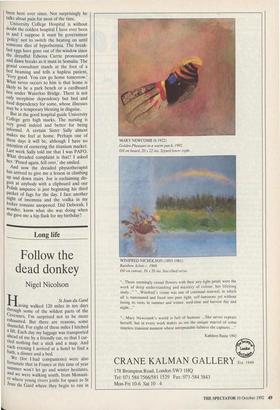Long life
Follow the dead donkey
Nigel Nicolson
1-1St Jean du Gard aving walked 120 miles in ten days through some of the wildest parts of the Cevennes, I'm surprised not to be more exhausted. But there are reasons, some shameful. For eight of these miles I hitched a lift. Each day my luggage was transported ahead of me by a friendly car, so that I car- ried nothing but a stick and a map. And each evening I arrived at a hotel to find a bath, a dinner and a bed. We (for I had companions) were also fortunate that in France at this time of year summer won't let go and winter hesitates, and we were walking south, from Monasti- er where young rivers jostle for space to St Jean du Gard where they begin to, run in
the opposite direction. A stonily austere country gives way to glades of Spanish chestnut and ends in Mediterranean lush- ness with figs, cypresses and olives.
As you walk, you gain in strength and stamina, but not as much as I would have liked. There comes a point where years can be shed no further. The steepest paths were as menacing at the end as at the beginning, and many of them were little more than cascades of loose stones which if bonded together would form leaning tow- ers. The secret is to stare at your boots and stop talking. Every slope seems flat when viewed from five feet above, and conversa- tion on the ascent is unendurable. My most constant companion, John Doyle the painter, was highly considerate, agreeing with me that there is a fellowship more quiet even than solitude. Being a man brimming with stories of his varied life and having a huge bank balance of remem- bered verse, he confined them to designat- ed halts and delectably level ground, of which by far the best is an abandoned rail- way line. He was the map-reader, the water-carrier, the morale-booster, the ini- tiator and organiser of the entire expedi- tion. These hundred miles are only a stitch in the vast journey he contemplates, from Canterbury to Rome, which he will illus- trate with his paintings and publish with a commentary in 1997 — 1,400 years after St Augustine did the same journey in reverse.
Our route was pioneered by Robert Louis Stevenson in 1878 and described by him in Travels With a Donkey. He named the donkey Modestine, and she has become the most famous donkey in history since Christ entered Jerusalem, largely because Stevenson treated her abominably, whack- ing or goading her every step of the way. He wept when he sold her at the end of the journey, but later editors consider this to be untrue, a sop to the outraged reader. His book, however, remains one of the most charming in our literature, and a won- derful guide. The country has scarcely changed in a hundred years. When he writes of the glad noise of the bursting streams, or of the stone pillars set to mark the way in mist or snow, the same streams burst for us and the pillars still stand there like ageless monoliths.
But not always. Like Stevenson, we sometimes lost our way. Inexplicably a well-trodden path would suddenly termi- nate in a cataract of boulders fatal to a weak ankle. At one such point, descending from Mont Lezere, our map-marker had written in red ink the number 100. It could not possibly be a spot-height: we stood at over 1,200 metres. I offered the suggestion that it was not the number 100, but the word `loo'. My companions rejected it. There was no need to advertise conve- niences in so vast a wilderness. So we stum- bled downwards, the swollen stream applauding every tentative footstep. It had no problem with the descent, but seemed to be in sympathy with ours.



























































 Previous page
Previous page